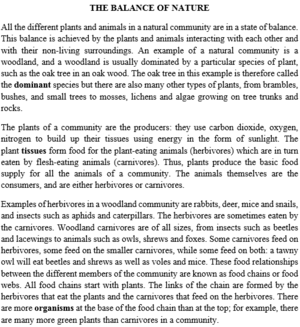Read the passage and mark the letter A, B, C or D to answer the following questions.
Most sources of illumination generate light over an appreciable period, and indeed if an object is lit for a very brief time (1ess that 1/25 second), the human eye will not react in time to see the object. A photographic emulsion - that is, a light-sensitive coating on photographic film, paper, or glass - will, however, record much shorter bursts of light. A photographic flash can therefore be used to capture high-speed movement on film as well as to correct deficiencies of the normal surrounding lighting. Photoflash is now generated electronically, but the earliest form, first used in 1864, was a paper bag containing
magnesium wire and some oxygen-rich substance, such as potassium chlorate. When the bag was ignited, the metal burned with an intense flash. A contemporary observer reported that "this quite unsafe device seems to have done nothing worse that engulf the room in dense smoke and lead to pictures of dubious quality and odd poses.”
The evolution of the photoflash was slow, flashbulbs, containing fine wire made of a metal, such as magnesium or aluminum, capable of being ignited in an atmosphere of pure oxygen at low pressure, were introduced only in the 1920's. In the earliest type, the metal was separated from the oxygen by a thin glass bulb. The flash was fired by piercing the bulb and allowing the oxygen to come into contact with the metal, which ignited spontaneously. Later bulbs were fired by an electric battery, which heated the wire by passing a small current through it. Other combinations, such as the pairing of oxygen difluoride with zirconium, have also been used. In each case enough energy is given out to heat the oxidizable metal momentarily to a white hot emission of visible light. The smoke particles are so small that they cool rapidly; but since they are white, they contribute to the brilliance by reflecting the light from their still glowing neighbors. A slightly bigger form of the metal will burn for a longer time.
The word "momentarily" in paragraph 2 is closet in meaning to ______.
A. effortlessly
B. briefly
C. electronically
D. gradually



Đáp án B
Từ “momentarily” trong đoạn 2 gần nghĩa với từ ___________.
A. effortlessly /'efətlisli/ (adv): một cách dễ dàng
B. briefly /'bri:fli/ (adv): một cách ngắn gọn
C. electronically /ilek'trɔnikli/ (adv): bằng điện tử
D. gradually /'grædjuəli/ (adv): dần dần, từ từ
Căn cứ vào ngữ cảnh đoạn 2:
“In each case, enough energy is given out to heat the oxidizable metal momentarily to a white hot emission of Visible light.” (Trong mỗi trường hợp, một năng lượng vừa đủ được cung cấp để đốt cháy kim loại có thể oxy hóa trong giây lát để phát ra ánh sáng nóng trắng mà mắt thường có thể thấy được.)
=> Do đó, đáp án là B